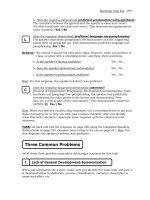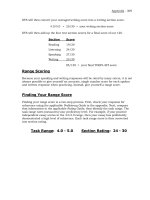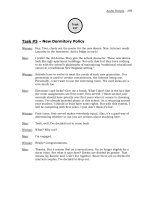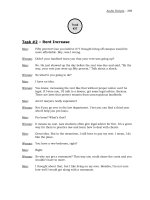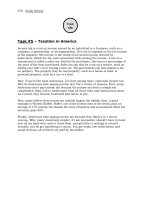Speaking and Writing Strategies for the TOEFL iBT part 37
Bạn đang xem bản rút gọn của tài liệu. Xem và tải ngay bản đầy đủ của tài liệu tại đây (160.6 KB, 10 trang )
Audio Scripts - 349
Task #4 – Organic Food
A major trend in the food industry is the increasing popularity of organic food. Yes,
organic is more expensive. There is no denying that, just as there is no denying the
health risks associated with eating non organic strawberries. Most are unaware
that non organic strawberries are one of the most chemically contaminated fruits
you can buy. Why? Because farmers apply two chemicals to every crop: a pesticide
to protect the fruit from insects and a fungicide to protect the roots from fungus.
Both the pesticide and the fungicide contain chemicals that have been linked to
breast cancer in woman and to a 50% reduction in sperm count in men. By eating
organic strawberries, you can substantially reduce your exposure to these risks.
The author goes on to say that organic food is hard to find. This is simply not true.
All you have to do is go to your local grocery store and you will find organic food.
Many of the bigger stores, for example, even have organic sections. Not only that
but Wal-Mart now offers a wide variety of organic produce. In fact, I buy a lot of
organic products at Wal-Mart, such as milk and cottage cheese and, yes, even
organic rice.
As for non organic versus organic milk, of course, there’s no difference in taste.
Why should there be? The whole point of organic milk is not to change the taste
but to eliminate pesticides and other man-made chemicals from the milk
production process. A big part of that process is the genetically engineered growth
hormone rBGH. Farmers give their cows rBGH which, in turn, makes the cows
produce far more milk than is naturally possible. Worse, rBGH stays in the milk
and enters your body when you drink it. Moreover, research has linked rBGH to
colon, breast and prostate cancer.
In the end, buying organic is an investment in your health. Personally, I don’t mind
paying a little extra. At least I know what I’m eating.
Track
#7
350 - Audio Scripts s
Task #5 – Funding Space Exploration
Look, how can anyone talk about funding space exploration when here in America
13 million children live in poverty? That number increased more than 11 percent
between 2000 and 2005, and it’s only getting worse. And you want my tax dollars
to fund another joy ride to the Moon, or worse, Mars? I don’t think so.
But what about all the wonderful inventions that have come from investing in
space? Imagine if instead of ski boots, we had a functioning health care system;
and instead of edible toothpaste, we had an educational system that actually
worked, or a high-speed rail system linking the major cities. But no, what do we
have? Joy sticks. Seriously, we don’t need to sink any more money into space
exploration. What we need is more social responsibility down here on Mother
Earth.
And what about space travel? Imagine, honeymooning on the Moon or Mars. Very
romantic. And expensive. Case in point: a round trip ticket on a Russian Soyuz
spacecraft heading to the International Space Station will cost you a cool $25
million. Will space travel get any cheaper? Not likely. Space tourism is, and will
always be, the playground of the super rich.
Finally, those who support funding a new era in space exploration argue that we
must answer the big question: Are we really alone in the cosmos? My answer to
that is: Who cares! We have children going hungry; our bridges and roads are
falling apart; our jobs have vanished overseas and our educational system is a
disgrace. I say forget the little green men and the honeymoon suite on Mars, and
focus on the average guy and gal struggling to make ends meet on Main Street.
Track
#8
Audio Scripts - 351
Sample Lecture – Animal Behavior
Good afternoon. In this lecture, we’ll focus on a common nocturnal animal, the bat.
There are two types of bat: micro bats, or true bats, and mega bats, also called fruit
bats. Let’s start with mega bats.
Size wise, mega bats are from two to sixteen inches in length. Mega bats have
extremely sensitive sight and smell. This helps them locate the flowers and fruit
upon which they feed. It is while eating that mega bats play an important role in
the distribution of plants. Like bees, mega bats serve as pollinators. When they lick
nectar or eat flowers, their bodies become covered in pollen which they, in turn,
carry to other trees and plants thereby acting as pollinators. In fact, many of the
fruits and vegetables on our tables, such as bananas and peaches, would not be
there if mega bats did not pollinate plants and trees.
Next are micro bats. As the name implies, micro bats are quite small, about the
size of a mouse. To find food, micro bats use echolocation, high frequency sounds
they bounce off insects. The most common micro bat is the vesper or evening bat.
Like mega bats, micro bats play an important role in the environment. The average
vesper bat, for example, can eat one thousand mosquitoes in one night. By doing
so, they control the mosquito population.
Track
#9
352 - Audio Scripts s
Task #1 – The American Civil War
Of all the generals in the American Civil War, one stands above all the rest: Robert
E. Lee. Lee was American nobility. He was born and raised in Virginia. His father
was a hero of the Revolutionary War while Lee himself married George
Washington’s granddaughter. In 1861, Lee was a colonel in the United States Army
when the South left the Union. Lee, claiming he could not draw his sword against
his native Virginia, resigned his commission and was soon leading the Army of
Northern Virginia.
Like most great military generals, Lee was a gambler. Two battles illustrate this
tendency. The first is the battle of Chancellorsville in May, 1863. There, Lee broke
all the rules of military engagement. Faced by a Union army twice the size of his
own, Lee divided his much smaller army not once, not twice, but three times. In
the process, Lee defeated the Union army and established his reputation as a
general equal to Napoleon. Time and again, Lee defeated the much larger Union
Army.
While Chancellorsville was Lee’s greatest victory, the battle of Gettysburg, in July,
1863 was Lee’s greatest defeat. On the third day of battle, Lee, convinced that one
final blow would break the Union line, sent the Army of Northern Virginia marching
across a mile-wide field. The waiting Union army annihilated Lee’s men. The South
never recovered.
At war’s end, many in the North wanted Lee hung for treason. However, Lee never
stood trial. Lincoln wanted reconciliation not revenge.
Track
#10
Audio Scripts - 353
Task #2 – Seamounts
Seamounts are of great interest not only to biologists but to the commercial fishing
industry as well. And for good reason. The nutrient rich water around a seamount
is home to an immense variety of fish, many of which have commercial value. One
such fish is the orange roughy.
In the mid 1970’s, orange roughy was found in great numbers around seamounts
near New Zealand. The greatest concentrations were found one kilometer down, a
depth once thought impossible to fish. But this did not stop the fishing industry.
No longer did depth protect the fish. Helped by new GPS technology, bottom
trawling was born. Bottom trawling involves dragging a net across the ocean floor.
This is a very destructive form of fishing for not only does the net catch orange
roughy, but it also destroys the ocean floor and catches other species that are not
commercially valuable. This method of fishing was so effective, and the demand for
orange roughy so great, that they were practically wiped out.
Another fish directly impacted by the bottom trawling is the armorhead. In the
1960’s, huge numbers of armorheads were discovered around seamounts
northwest of Hawaii. In no time at all, Russian and Japanese fishing fleets virtually
wiped out the armorhead. Like orange roughy, armorhead stocks have yet to
recover.
Track
#11
